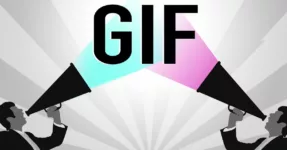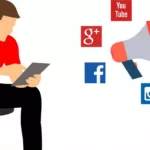It may have turned 30 last year, but the GIF’s everyday use exploded when Facebook, at long last, integrated the language into its comments. Certain markets had been popularly using the animated communication for years, but once the social-media giant added the GIF button to its primary app and website, common communication changed forever.
Entire conversations – conversations that actually make sense – now consist of nothing but a series of moving images – snippets of pop culture – that more vividly convey a message than any words could.
Granted, GIFs weren’t a rarity prior to Facebook’s June 2017 update – just less than 13 billion were sent in the prior year via Facebook’s Messenger app, triple the total of the year before that. Andsilent video snippets were even more popular among the younger markets.
In fact, Business Insider’s BI Intelligence reported that by 2016 messaging and chat apps – many of which heavily focus on visual content over text – surpassed social networks such as Facebook and Twitter in worldwide popularity.
Butfor the past six or so months,GIFs have been easily accessible to Facebook’s more than 1.3 billion daily users. The animated format dominates countless digital conversations as social-media users search for creative visual messages to illustrate their thoughts.
Just as they send a nonverbal message, GIFs need no verbal definition. They fall in the grey area between image and video, and they communicate universally-understood rebuttals and emotions by employing humor, irony and sarcasm better than text ever could. But since this article happens to be written in actual words, we’ll go ahead and define the term.
A GIF is “a lossless format for image files that supports both animated and static images,” according to a Google search. Is it really that simple?
“A reaction GIF seems to be used more creatively as a meta-commentary than purely authentically for conveying emotion,” linguist Chi Luu told the JSTOR Daily audience. “These emotional responses are often well-worn tropes from film and narrative.”
Whether pronounced “jif” or “gif,” GIFs have grown even more popular than emojis as they allow for more flexible commentary and subtler humor than their single-image counterparts. Plus, GIF’s pop-culture references can instantly capture audiences’ attention and foster shared emotions.
The GIF’s popularity has expanded its use into additional capacities. Although they can’t be used by brands on Facebook, their increased popularity has led to GIF’s use in marketing messages across the web, promoting brands in abbreviated video snippets more likely to be viewed in their entirety than other moving-picture formats.
Even better, the most successful GIFs are frequently those that repurpose existing video assets – favorite film, television and other video content from pop culture, as well as depictions of history’s most memorable and infamous characters. Thus, they’re not only incredibly eye-catching, but highly effective visual content is available to promote a message without the investment of creating it.
The GIF Is Older Than Most Millennials
Insiders can agree the GIF’s age is obvious from the limited capabilities of its earliest examples– the first GIFs were limited to 8 bits per pixel and a 256-color palette, and the animations were even more restrictedby the use of slow processors and modems. Still, many 2018 users are surprised to learn the Graphics Interchange Format was developed by CompuServe’s Steve Wilhite all the way back in 1987.
Wilhite wanted a smaller file size for animated images. He created the GIF, a soundless series of images looped continuously to generate a moving picture.The motion was created by looping a series of still images, just as the earliest motion pictures were made in early 20th-century film.
If you can, remember back to the machines most people used in ’87, and you can appreciate the quality of the first GIFs. Still, audiences of the era were fascinated by the animations on their screens. And when Netscape Navigator launched in 1994, it brought with it the animation loop – and the GIF sealed its place in history.
As our technology advanced, so did the quality of the GIF. Granted, developers shied away from the format when copyright disputes held the GIF up in court for a decade or so. But by the time Tumblr launched in 2007, the GIF tag became a favorite among early social-media users, and to this day it remains one of the site’s most popular tags.
The advent of smartphones and social media has coincided with an explosion in the now 30-year-old visual language. Users can send a stronger and more precise message with a reaction GIF than they could with text messages and email, both communication methods often misinterpreted and misunderstood.
“We have gotten acclimated to seeing not just graphics but animated graphics for quite some number of years,” linguist Naomi Baron told The Huffington Post. “Think about the moving ads that have been on Weather.com or name your favorite website for a very long time.”
Why Do Brands Choose GIFs?
Facebook may not yet encourage GIFs within sponsored posts, but that doesn’t mean the format hasn’t already made a powerful impact on the advertising community. Brands can use GIFs to interact with their audiences and to showcase multiple products in a single image. Plus, because of their short format, GIFs are more likely to be viewed in their entirety than other visual content.
Why are GIFs so valuable in the online marketplace? Plenty of reasons. They’re trendy, entertaining, easily shareable and contain greater context than a textual message. After all, it’s well-known that the average attention span of an online audience is a mere eight seconds. With an average length of just 2-5 seconds, a GIF is the ideal format to catch the eyes of even those scrolling down the page.
“You can communicate far more in a GIF than you can with a static image and copy,” said Kara Vorhes, creative director of LA marketing agency Harmonica. “GIFs allow for theatrics — you can set your audience up for a big revealor tell a story with a bigger narrative arc.”
Think about it: Can you more strongly communicate excitement to an audience of Gen Xers by typing, “I’m so excited,” or by posting a GIF of Jessie Spano crying out to Zack Morris on a “very special episode” of Saved by the Bell?
GIFs are Simple to Share on Social Media
Thanks to sites such as Imgur and Giphy, which host a plethora of GIFs of all types, social media users can easily share the format through social-media channels. Gifs can express emotions, reactions and overall personality more effectively than text.
Choosing the right GIF can target desired emotions within audiences through humor, irony and sarcasm in ways that textual messages often fail. And it can do all that in less time than it takes a user to scroll on by.
Social-media marketers have gotten incredibly crafty in their use of GIFs. One of the most effective methods has been illustrating step-by-step procedures to use a product – like an engaging but short infomercial made for a Facebook newsfeed.
GIFs Carry a Powerful Punch in Content Marketing
The popularity of the GIF isn’t limited to social-media spheres. After all, Cisco once predicted that 84 percent of all U.S.-based Internet traffic would be in a video format by this year.
GIFs are inanely popular among content marketers because of how easily audiences consume them. It doesn’t take as much effort to capture attention with a clip of a weeping James VanDerBeek or an ecstatic Doc Brown. The memes have already cemented emotional connotations within audiences around the world. And because the carry such a powerful punch, they can carry a great deal of weight in very short time periods.
The smaller format also makes GIFs ideal for mobile consumption. Since they only last a few seconds, the smaller files load faster than videos, but the automatic loop makes them more effective than a single image.
Is it any wonder than according to Giphy CEO Alex Chung, if a picture is worth a thousand words, and “the average GIF contains sixty frames, then they’re capable of conveying 60,000 words – the same as the average novel.”
GIFs Are Valuable SEO Strategies
Google has been integrating GIF files with its search capabilities for the past several years. The company started allowing the use of in-line .gif files on Google Hangouts and Gchat in 2013, while Google Docs and Google Slides began supporting the format the same year. But the greatest impact occurred in 2015, when Google added GIFs to its image-search capabilities through a Chrome Extension.
Google’s web crawlers treat GIF files as rich media, similar to .jpeg or .swf files. SearchEngine Journal’s Chandal Nolasco da Silva explained the process in a 2014 post.
“As Googlebot crawls the internet indexing over 60 trillion website pages, it is mostly reading the site’s HTML code,” da Silva wrote. “As soon as there is any form of dynamic content be it rich media files (like flash or GIFs) or personalized content, indexing becomes more complicated depending on how the content is presented to Google.”
Still, da Silva points out, Google’s support pages note that “guidelines for rich media content are simple: provide the text-equivalent to any non-text files.” In essence, optimize GIFs for search with plenty of metadata, the same as any other visual content. Communicate your message to Google not with on-image text, but with descriptive file names, alt descriptions and other off-page and HTML details.
GIFs Breathe New Life Into Email Marketing
No matter how many trendy and innovative online communication channels are introduced, email is still the first and one of the most effective methods of content distribution. And that content includes GIFs.
In fact, email and GIFs have a symbiotic relationship. While email can help distribute a GIF, a GIF can definitely spice up an email. Embedding a GIF into an emailed newsletter can breathe new life into a redundant mailer.
The added animation can grab hold readers’ attention and send a more powerful message than monotonous blocks of text. In fact, according to a Campaign Monitor study, animated emails generated a click-through rate 26 percent higher than static newsletters. Marketing teams can create their own GIFs using online tools like Bannersnack, which helps users design GIF banners perfect for electronic newsletters and email signatures.








